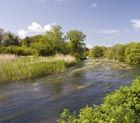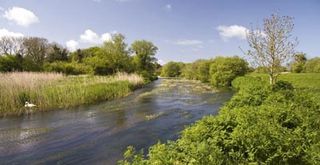Book review: Life of a Chalkstream
Mark Hedges salutes an author who’s infectious love of chalkstreams is a joy to behold


Countryside Life of a Chalkstream Simon Cooper (William Collins, £16.99 *£13.99)
Of course, the water here is as clear as gin, and much more valuable,' commented my ghillie, nodding at the chalkstream we were standing beside as he tied on another fly. He probably wasn't joking. Britain is home to 95% of the world's chalkstreams and they're our equivalent of the rainforests: precious, endangered and utterly beautiful. They are also, rather extraordinarily, totally manmade.
The author of Life of a Chalkstream, Simon Cooper, runs Fishing Breaks, a company that provides fishing on many of the finest rivers in the land. He's a renowned fly-fisher himself and, in this book, he writes as well as he casts.
This story of the triumphant return of a neglected stretch of a river at Gavelwood echoes Henry Williamson's Salar the Salmon in many delightful passages on the various animals that inhabit this ecological wonderland. A perfect chalkstream is the ultimate environment for trout and, like so many field sports, what's good for the quarry species is also heaven for others. If the trout are happy, the insects, water voles, bullheads, kingfishers, swans, otters, bats, field mice and salmon will be, too.
Chalkstreams were initially created by man to drain swampy marshes into channels that could drive a watermill; this, in turn, created wondrous, fertile pasture in the fields near the newly formed river. As the water mills passed into history, the rivers found a new role and the drowners arrived. These men worked in bitter winters to flood the surrounding fields in order to ward off harsh frosts.
Chalkstreams flow at a constant 10˚ and flooding the pasture through a series of intricate sluices kept the grass free of frosts and enriched the land with the water's nutrients. Later, in Victorian times, the art of dry fly-fishing was perfected by Frederic Halford on the River Test, creating a mad rush of grandees wanting to join in the latest field-sport fashion.

Chalkstreams, like enormous, watery gardens, need managing. The gravel needs to be kept from becoming silted up, the banks need to be regularly cleared of vegetation and, most importantly, the weed growing in the river itself must be tended like a perfect herbaceous border.
Sign up for the Country Life Newsletter
Exquisite houses, the beauty of Nature, and how to get the most from your life, straight to your inbox.
This weed is critical-it manages the flow, oxygenates the water and provides a home for the millions of insects at the bottom of the food chain. A monthly weed cut to create a perfect chequerboard-pattern takes place the length of the river.
As the author and his team battle to turn Gavelwood back into a pristine trout river, the animals represent the trials, tribulations and successes. As the river improves, trout start to lay their eggs where none have been laid for decades. The cycles of life, from the mayfly that hatches as an insect before mating and dying in a single day, to the salmon and eels that spend their lives both at sea and in freshwater, are all revived. Mr Cooper is in love with chalkstreams and anyone who reads this splendid book will soon hold the same view.
* Follow Country Life magazine on Twitter
Country Life is unlike any other magazine: the only glossy weekly on the newsstand and the only magazine that has been guest-edited by HRH The King not once, but twice. It is a celebration of modern rural life and all its diverse joys and pleasures — that was first published in Queen Victoria's Diamond Jubilee year. Our eclectic mixture of witty and informative content — from the most up-to-date property news and commentary and a coveted glimpse inside some of the UK's best houses and gardens, to gardening, the arts and interior design, written by experts in their field — still cannot be found in print or online, anywhere else.
-
 If heaven is on earth, it might be in this home with a converted chapel that is now a swimming pool
If heaven is on earth, it might be in this home with a converted chapel that is now a swimming pool5 Wood Barton Town House is part of an exclusive 80-acre development in Devon that also comes with fishing rights on the River Avon and four bedrooms.
By James Fisher Published
-
 An Italian-inspired recipe for lemon-butter pasta shells with spring greens, ricotta and pangrattato
An Italian-inspired recipe for lemon-butter pasta shells with spring greens, ricotta and pangrattatoSpring greens are just about to come into their own, so our Kitchen Garden columnist reveals exactly what to do with them.
By Melanie Johnson Published
